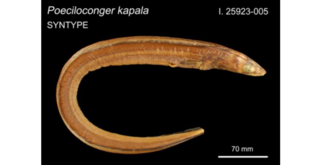Herbstosaurus is the name given to a genus of pterosaurs that lived during the Late Jurassic period, in what is now Argentina. In 1969 Argentine paleobotanist Rafael Herbst in the province Neuquén at Picun Leufú dug up a piece of sandstone holding a number of disarticulated bones of a small reptile. At the time it was assumed the rock dated to the Middle Jurassic (Callovian), about 163 million years ago.

Eomeropidae is a family of aberrant, flattened scorpionflies represented today by only a single living species, Notiothauma reedi, known from the Nothofagus forests in southern Chile, while all other recognized genera in the family are known only as fossils, with the earliest definitive fossil known from Liassic-aged strata, and the youngest from Paleogene-aged strata.

The Nematoceran family Axymyiidae is the sole member of the infraorder Axymyiomorpha, though it is often included within the infraorder Bibionomorpha in older classifications. It is known from only nine species in four genera, plus eight fossil species.
Urbacodon is a genus of troodontid dinosaur, a type of small carnivore. It lived in Uzbekistan during the early Late Cretaceous Period, about 95 million years ago.

Anthemideae is a tribe of flowering plants in the family, Asteraceae, and the subfamily Asteroideae. They are distributed worldwide with concentrations in central Asia, the Mediterranean Basin, and southern Africa. Most species of plant known as chamomile belong to genera of this tribe.
Notoseris is a genus of Asian flowering plants in the tribe Cichorieae within the family Asteraceae. The plants are native to Asia, primarily China.
Opisthopappus is a genus of Chinese flowering plants in the chamomile tribe within the daisy family.
Paraprenanthes is a genus of East Asian plants in the tribe Cichorieae within the family Asteraceae, most of the species found only in China.
The Haifanggou Formation, also known as the Jiulongshan Formation, is a fossil-bearing rock deposit located near Daohugou village of Ningcheng County, in Inner Mongolia, northeastern China.

Lichnomesopsyche is an extinct genus of mesopsychid mecopteran which existed in what is now China during the middle Jurassic period. It was found in the Daohugou Bed. It was named by Ren Dong, Conrad C. Labandeira and Shih ChungKun in 2010. Three species have been named, which can be distinguished by their differing male genitalia.
Vitimopsyche is an extinct genus of Mecopteran which existed in what is now northeastern China during the early Cretaceous period. It contains the species Vitimopsyche kozlovi and V. torta.

Mongolarachne is an extinct genus of spiders placed in the monogeneric family Mongolarachnidae. The genus contains only one species, Mongolarachne jurassica, described in 2013, which is presently the largest fossilized spider on record. The type species was originally described as Nephila jurassica and placed in the living genus Nephila which contains the golden silk orb-weavers.
This list of fossil arthropods described in 2013 is a list of new taxa of trilobites, fossil insects, crustaceans, arachnids and other fossil arthropods of every kind that have been described during the year 2013. The list only includes taxa at the level of genus or species.
Chaetoseris is a genus of East Asian flowering plants in the dandelion tribe within the sunflower family.
Elachanthemum is a genus of Asian plants in the chamomile tribe within the daisy family.
Stenoseris is a genus of Asian plants in the tribe Cichorieae within the family Asteraceae.
This list of fossil arthropods described in 2010 is a list of new taxa of trilobites, fossil insects, crustaceans, arachnids and other fossil arthropods of every kind that have been described during the year 2010. The list only includes taxa at the level of genus or species.
Liadotaulius is an extinct genus of caddisflies. It is currently (tentatively) placed in the family Philopotamidae, though it has previously been placed in the extinct families Necrotauliidae and Dysoneuridae.
This paleoentomology list records new fossil insect taxa that were described during the year 2014, as well as notes other significant paleoentomology discoveries and events which occurred during that year.

Ariosoma kapala is an eel in the family Congridae. It was first described in 1990 by Peter H. J. Castle as Poeciloconger kapala. The holotype was collected by the New South Wales Fisheries Research Vessel Kapala on April 11, 1985, during a bottom trawl at a depth of 46-64 m. The species was named for the FRV Kapala. In 1998, Shieh-Chieh Shen moved the species to the genus Ariosoma.





